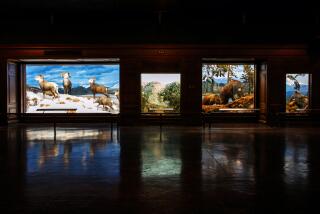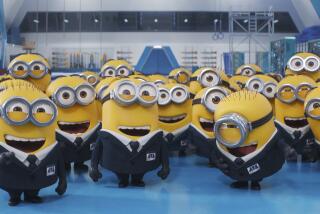Return of the Dinosaurs
- Share via
After 65 million years of extinction, dinosaurs are back, and as big as some of them were, they’re even bigger now.
While paleontologists continue to argue whether the beasts were cold- or warm-blooded, merchandisers are discovering that dinosaurs are, in fact, hot.
At a recent gathering in the Hollywood Hills, guests garbed in the latest prehistoric fashions chased each other with plastic clubs while munching on “carnosaurus” canapes and whacking pterosaur-shaped pinatas.
And at the Los Angeles County Museum of Natural History’s annual dinosaur ball, about 800 patrons in black tie or gown waltz among the petrified remains of the once-glorious creatures.
Accomplished “dinophiles” can also satisfy their lizardly cravings by dropping by Crayons at the Westside Pavilion, for a “Godzilla,” elsewhere known as a club sandwich. Or, on a jaunt to New York, they can visit the East Village’s Continental Divide, a bona-fide brontosaurus of a restaurant decked out in Early Jurassic and replete with prehistoric beasties outside the door, on the walls, over the bar and in the drinks. It is, as owner Allan Roy says, “the ultimate in retro.”
In Los Angeles, serious, hard-core yupp-a-sauruses can be found at the County Museum of Natural History or at the Page Museum, mulling over the latest fortunate--or unfortunate--to have been fished from the La Brea tar pits after a few eons of pickling.
Then it’s off with the kiddies for a day at Knott’s Berry Farm, where the $7-million Kingdom of the Dinosaurs ride, which opened in May, is still pulling them in.
Next, it’s home for a soak in the primordial hot tub and a scrub with dinosaur egg-shaped bars of soap that have little plastic creatures at their core. Then, a nice cup of tea from the Tea-Rex teapot, at $65, a brachiosaurian bargain.
And, as darkness falls and a new Ice Age begins, it’s off to bed with stuffed designer dinosaurs from Carousel by Guy, the Pierre Balmain of plush.
“What you’re seeing,” says Mark Hallet, a Pasadena-based artist, naturalist and writer, whose paintings figure prominently in the County Museum’s ‘Dinosaurs Past and Present’ exhibit--now traveling the continent--”is a dinosaur renaissance.”
If so, it’s not the first.
Don Glut of Burbank, who wrote “The Dinosaur Scrapbook” (Citadel Press, 1981), reports that in our century, dinosaurs have already enjoyed two major waves of popular interest.
The first began in 1933, when the Sinclair Oil Co. adopted the dinosaur as its logo and sponsored a dinosaur exhibit at the Chicago World’s Fair. The fad was later fueled by the release of “King Kong.”
Twenty years later, Life magazine helped kick off a second revival by putting dinos on its cover, in tribute to a then-popular series of nature books. King Kong was re-released, Hollywood unleashed a horde of brand-new dinosaurs ostensibly awakened by the Bomb, and dinosaur toys went into mass production for the first time.
Lisa Babylonia, one of two full-time paleontologists on hand at Knott’s Berry Farm, traces the origins of the current craze to the early 1970s. A series of fossil discoveries, as well as advances in biology and biomechanics, had forced scientists to revise their thinking on how dinosaurs looked and lived.
“For years we had thought dinosaurs were slow, stupid and boring creatures,” she says. “We learned that they were far more gregarious, possibly the result of being warm-blooded.”
The realization that dinosaurs may not have been huge, plodding dullards, doomed by their own faulty biological design, but rather, adaptive creatures that managed to reign for nearly 140 million years, made them intriguing once again.
“We’ve lifted them up by their tails and brought them out of the swamps,” Babylonia says.
It took a while, however, for the idea to become popular. Some say part of the credit for renewed interest could go to William Stout, a 38-year-old artist in Pasadena, whose book, “The Dinosaurs” (Bantam, 1981) was among the first to compile most of the new thinking--not to mention some exciting new art--within a single volume aimed at the general reader. Stout’s book had an initial run of 250,000 copies, and he is presently negotiating for a second edition.
According to artist Hallet, the present fascination for dinosaurs may be due to a growing awareness that they were not the fantasy animals depicted in film.
More Aware of Nature
“Dinosaurs have always captured the imagination,” Hallet says, “but once they were popular because they were these not-quite-real monsters. People were intrigued by the fancy that they might have once roamed the earth.
“Today, however, people seem much more aware of nature as it is, probably from decades of nature programs on TV. And, because of advances in our understanding of animals, which have made it possible for us to better understand dinosaurs, they have begun, quite possibly for the first time, to view dinosaurs as real animals.”
“This is certainly the most popular I’ve ever seen them,” artist Stout adds. “There are at least five new children’s shows in development, every major toy company has a dinosaur line slated for the end of the year, and I’m even seeing dinosaur belt buckles and earrings.”
Jodi Levin, a spokeswoman for the Toy Manufacturers Assn. in New York, says she’s noticed the onset of dino-mania for about a year.
“People are tired of high tech,” she says. “Last year’s sales of robot toys were already scaled down to half of what they were the year before.”
Frank Reysen, editor of Playthings, a New York-based magazine covering the toy industry, says the present spate of dinosaur toys is indicative of a back-to-basics movement.
“It’s very possibly a reaction against the huge licensing fees toy manufacturers have had to pay out for many of their television-related action figures and robots.”
Ironically, if any of the dinosaur TV shows take off--and judging from the response to the dinosaurs featured on “Pee-wee’s Playhouse,” it’s a sure bet some will--these shows will generate a new rush by toy makers to secure the rights to their characters.
For Karen Yoshikawa, vice president of merchandising at Knott’s Berry Farm, the big indicator that dinosaurs were the coming thing was their presence in fashion, specifically in T-shirts and ready-to-wear.
“Fashion is usually the leader,” she says. “Once it starts creating a trend, it usually moves into toys and housewares.”
Murray Garret, president of Diener Industries, a Chatsworth company that produces little dinosaurs given out by fast-food outlets and found in cereal boxes, says business has really skyrocketed during the last few years.
“We had our dinosaur molds for 15 years, but they never sold like this.” He says one cereal company recently ordered 10 million units, and he expects to produce 300 million before the year is out.
Hot Yuppie Item
Shelley Stephens, general manager for stores at the County Museum of Natural History, reports that while plastic dinosaurs are big sellers, the market has extended to more durable wares.
She says interest in the museum’s “Dinosaurs Past and Present” exhibit in 1985 led her to develop one of Mark Hallet’s paintings, a portrait of a Mamenchisaurus during a tender moment with one of her young, as a museum poster. She says it has become a best-selling item at museum shops throughout the country and is being purchased as fine art.
In fact, dinosaurs have become a hot yuppie item. Possibly because of their educational value, but also because they are trendy, dinosaurs are generating mammoth sales in art and jewelry. Knott’s Berry Farm, for instance, reports that fossils, priced from $30 to $1,500, are becoming a popular home-decorating item among the upscale.
Bonnie George, a modeling consultant at Faces Model Management in New York and an avid dinosauria collector, says: “They remind me of how young I truly am, and they inspire me to reach for my own stamp on eternity.
“What I’d really like to do, even more than being frozen cryogenically for eternity, is to scatter my fossils around when I’m done.”
Brynne Stevens is a story editor at DIC Enterprises, an animation-production house in Encino. Stevens, who is developing a syndicated children’s show called Dinosaucers, says the neat thing about dinosaurs is “they’re big, scary and don’t even have to listen to Mom and Dad.
“Better yet, they possess all the winning qualities of monsters while being real as well, which gives them a natural advantage over comic-book characters. And yet, they were real so long ago that they’re safe.”
But there seems to be a change in the way even children are responding to dinosaurs.
Only eight years ago, John Schowalter, a professor of pediatrics and psychiatry at Yale University, wrote that girls were turned off by the overt violence of dinosaur play among children. Moreover, he said adults associated dinosaurs with science, which has traditionally been regarded as more of a male domain.
“When I was a kid,” 38-year-old Stout said, “dinosaurs were strictly for boys. But now, at the slide shows I give at schools and museums, there’s a real cross-over in interest. I’m seeing as many girls as boys.”
Freudian Fantasies
Stout suggests that the sexual revolution has been partly responsible for this, although small children have still been noted to draw skirts on brontosauruses, indicating that dinosaurs loom largely in the Freudian fantasies of some.
“I think that girls are also responding to recent discoveries that dinosaurs were more nurturing than previously thought, that they reared their young and may have even given birth to them live.”
Author Ray Bradbury regards the present mania for dinosaurs with more than a little wistfulness. After all, he wrote about them in his early stories and wrote the screenplay for a well-regarded ‘50s dinosaur movie.
“This is something that should have happened when I was a kid,” he complains.
“Dinosaurs were like horror films back then. There were few of them (films) around but we all knew we loved them. Yet the studios and entrepreneurs were too dumb to see the market.
“So now we witness the belated rebirthing of the dinosaur, due in large part to the past stupidity of mankind.”
Bradbury believes that dinosaurs are doing particularly well lately because “they belong to all races and both sexes. Their appeal is universal.”
But Hallet, who has in a sense devoted much of his efforts to improving the dinosaur’s image, wonders if all the fuss might not be misplaced.
“I find it increasingly ironic,” he says, “that so much attention is being paid to creatures of the past, while, even now, some of the most beautiful animals that have ever existed are becoming extinct because of human mismanagement.”
More to Read
Sign up for Essential California
The most important California stories and recommendations in your inbox every morning.
You may occasionally receive promotional content from the Los Angeles Times.













